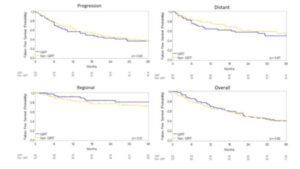60-70% of cancer patients receive some type of radiation therapy. For some cancers, radiation therapy alone is an effective treatment. The purpose of radiotherapy is to destroy cancer cells and slow tumor growth while limiting the harm to nearby healthy tissue. When it is not possible to destroy all of cancer, doctors may implement palliative radiotherapy (radiotherapy conducted with the purpose to shrink tumors and relieve symptoms). Radiotherapy before surgery can help to shrink the tumor(s). Radiotherapy after surgery can treat remaining cancer cells. (ASCO, Cancer.NET) This article will address:
- The effectiveness and benefits of radiotherapy
- Popular radiotherapy methods and research to determine their impact
- Guideline-based AI Segmentation, GBAIS™, software for radiotherapy treatment planning
How effective is Radiotherapy?
Radiotherapy is an effective treatment, with a curability rate of over 40% depending on the type of cancer, stage of cancer, and the radiotherapy technique used. In certain tumors, such as lung or prostate, radiotherapy can be used as a less invasive method than surgery (excision), while achieving comparable results to excision. (HC Marbella) Furthermore, radiotherapy has preserved the organs and organ function in laryngeal cancer patients. (Nguyen, Nam P., et al.)
Radiotherapy Methods and their Impact
External-beam radiotherapy (EBT) with the Iodine-125 Implant
EBT is a method for delivering high-energy, x-ray, or electron beams to a patient’s tumor. Usually, the beams are generated by a linear accelerator and targeted to destroy cancer cells, while sparing surrounding normal tissues. EBT has also been used as an effective palliative method (Radiology Info) Iodine-125 seed implantation is a radiotherapy implant that can continuously release low radiation doses or it can deliver a high radiation dose to tumors without damaging adjacent normal tissues. (Tian, Li-Jun, et al.)
A recent study conducted at Binzhou Medical University Hospital’s Oncology Department evaluated the efficacy and safety of combined EBT with iodine-125 seed implantation for elderly patients with advanced non-small-cell lung cancer (NSCLC) invading the chest wall. Researchers found that the combined-modality therapy significantly restricted tumor growth while significantly relieving cancer-related pain. 71.4% of the patients’ tumors were destroyed or significantly reduced by the combined treatment of EBT. Researchers concluded that the combined therapy of EBT with and permanent iodine-125 seed implantation is deemed an efficacious and safe treatment option for elderly patients with advanced NSCLC. (Tian, Li-Jun, et al.)

Three-dimensional conformal radiation therapy (3D-CRT)
3D-CRT is a common radiation therapy used to treat cancers in many parts of the body, utilizing radiation beams that are shaped to enter the patient from multiple angles to spare as many healthy tissues as possible. (UAB Medicine)
Children’s Oncology Group, in collaboration with National Cancer Institute (NCI), is conducting a phase III trial study to determine the side effects of chemotherapy combined with 3D-CRT, with the use of patients’ stem cells (autologous peripheral blood stem cell transplant) to determine its effectiveness in treating young patients with cancer of the brain, spinal cord, and central nervous system. The study will be completed in 2023. This treatment has the potential to be an effective combined method for young cancer patients. (Children’s Oncology Group)

Intensity-modulated radiation therapy (IMRT)
IMRT is an advanced type of radiation therapy used to treat cancer and noncancerous tumors. IMRT uses advanced technology to manipulate photon and proton beams of radiation to conform to the shape of a tumor. Of its many benefits, IMRT allows for greater dose conformity to the tumor target. Researchers at Fox Chase Cancer Center sought to determine the severity of acute skin toxicity with IMRT for breast cancer patients. The researchers determined that IMRT is associated with a decrease in the severity of radiotherapy-related skin peeling and skin toxicity. (Freedman, Gary M., et al.)

Image-guided radiation therapy (IGRT)
IGRT uses imaging during radiotherapy to improve the precision and accuracy of treatment delivery. Researchers at Wake Forest School of Medicine and University of California San Diego sought to determine whether IGRT improved clinical outcomes for advanced lung cancer patients, and found that IGRT with daily cone-beam computed tomography (a tool used to determine tumor shrinkage during radiotherapy) showed an improvement in the therapeutic ratio relative to patients treated without this technology. (Kilburn, Jeremy M., et al.)

Stereotactic radiation therapy (SRT)
SRT gives radiotherapy from different angles around the body. The beams meet at the tumor, allowing the tumor to receive a high dose of radiation and the tissues around it receive a much lower dose. This helps lower the risk of side effects. Researchers at Allegheny Health Network Cancer Institute, and Allegheny General Hospital measured the effectiveness of SRT treatment for patients with paragangliomas (a tumor that forms near certain blood vessels and nerves outside of the adrenal glands). 88% of the patients treated with SRT had a 5-year control rate and 81% of patients reported improved or resolved symptoms after treatment. (Gigliotti, Michael J., et al.)
Guideline-Based AI Segmentation Radiotherapy Software for Your Clinic
MVision AI is the pioneer of guideline-based AI segmentation, GBAIS™, radiotherapy software. MVision’s deep learning system helps you automate organ-at-risk contouring, including lymph nodes, to streamline your cancer treatment planning. MVision follows 12 consensus guidelines, including, ESTRO and RTOG. MVision’s models cover all major cancer sites and lymph nodes, including 147 ROIs. Robust, HIPAA, and GDPR compliant, MVision AI brings the highest quality radiotherapy planning SaaS solution for your oncology department.

MVision AI is active on LinkedIn, Twitter, Facebook, and Instagram. Follow us on social media and subscribe to our newsletter to stay up-to-date on the latest MVision AI news.
Are you eager to learn more? We welcome you to contact MVision AI:
c/o Terkko Health Hub, Haartmaninkatu 4, 00290 Helsinki, Finland.
Tel: +358 (0) 40 5489 229
Email: info (at) mvision.ai
For media inquiries:
+358 40 500 7915; pr (at) mvision.ai
Sources
ASCO, Cancer.NET. “Understanding Radiation Therapy.” ASCO, 23 Sept. 2020, www.cancer.net/navigating-cancer-care/how-cancer-treated/radiation-therapy/understanding-radiation-therapy.
Children’s Oncology Group. “Clinical Trial on Childhood Atypical Teratoid/Rhabdoid Tumor: 3-Dimensional Conformal Radiation Therapy, Autologous Hematopoietic Stem Cell Transplantation, Carboplatin, Cisplatin, Cyclophosphamide, Etoposide, Filgrastim, Laboratory Biomarker Analysis, Leucovorin Calcium, Methotrexate, Thiotepa, Vincristine Sulfate – Clinical Trials Registry – ICH GCP.” Good Clinical Practice Network, 2016, ichgcp.net/clinical-trials-registry/NCT00653068.
Freedman, Gary M., et al. “Intensity Modulated Radiation Therapy (IMRT) Decreases Acute Skin Toxicity for Women Receiving Radiation for Breast Cancer.” American Journal of Clinical Oncology, vol. 29, no. 1, 2006, pp. 66–70. Crossref, doi:10.1097/01.coc.0000197661.09628.03
.Gigliotti, Michael J., et al. “A 10-Year Experience of Linear Accelerator-Based Stereotactic Radiosurgery/Radiotherapy (SRS/SRT) for Paraganglioma: A Single Institution Experience and Review of the Literature.” Journal of Radio Surgery and SBRT, vol. 38, no. 15_suppl, 2018. Crossref, doi:10.1200/jco.2020.38.15_suppl.e14043.
HC Marbella. “La Importancia de La Radioterapia En El Paciente Oncológico.” HC Marbella, 16 Feb. 2021, www.hcmarbella.com/en/the-importance-of-radiotherapy-in-the-oncological-patient.
Kilburn, Jeremy M., et al. “Image Guided Radiation Therapy May Result in Improved Local Control in Locally Advanced Lung Cancer Patients.” Practical Radiation Oncology, vol. 6, no. 3, 2016, pp. e73–80. Crossref, doi:10.1016/j.prro.2015.10.004.
Nguyen, Nam P., et al. “Feasibility of Intensity-Modulated and Image-Guided Radiotherapy for Functional Organ Preservation in Locally Advanced Laryngeal Cancer.” PLoS ONE, edited by Chulso Moon, vol. 7, no. 8, 2012, p. e42729. Crossref, doi:10.1371/journal.pone.0042729.Radiology Info. “External Beam Therapy (EBT).”
Radiologyinfo.Org, 5 Mar. 2019, www.radiologyinfo.org/en/info/ebt.
Tian, Li-Jun, et al. “Efficacy and Safety Aiming at the Combined-Modality Therapy of External Beam Radiotherapy (40Gy) and Iodine-125 Seed Implantation for Locally Advanced NSCLC in the Elderly.” Cancer Management and Research, vol. Volume 13, 2021, pp. 5457–66. Crossref, doi:10.2147/cmar.s294313.
UAB Medicine. “3D Conformal Radiation Therapy (CRT).” UAB Medicine, 2021, www.uabmedicine.org/patient-care/treatments/3d-conformal-radiation-therapy-crt-?medallia=occ-survey#:%7E:text=Three%2Ddimensional%20conformal%20radiation%20therapy,much%20healthy%20tissues%20as%20possible.


